A Trainer’s Go-to ‘Reverse Pyramid Training’ Workout To Build Muscle
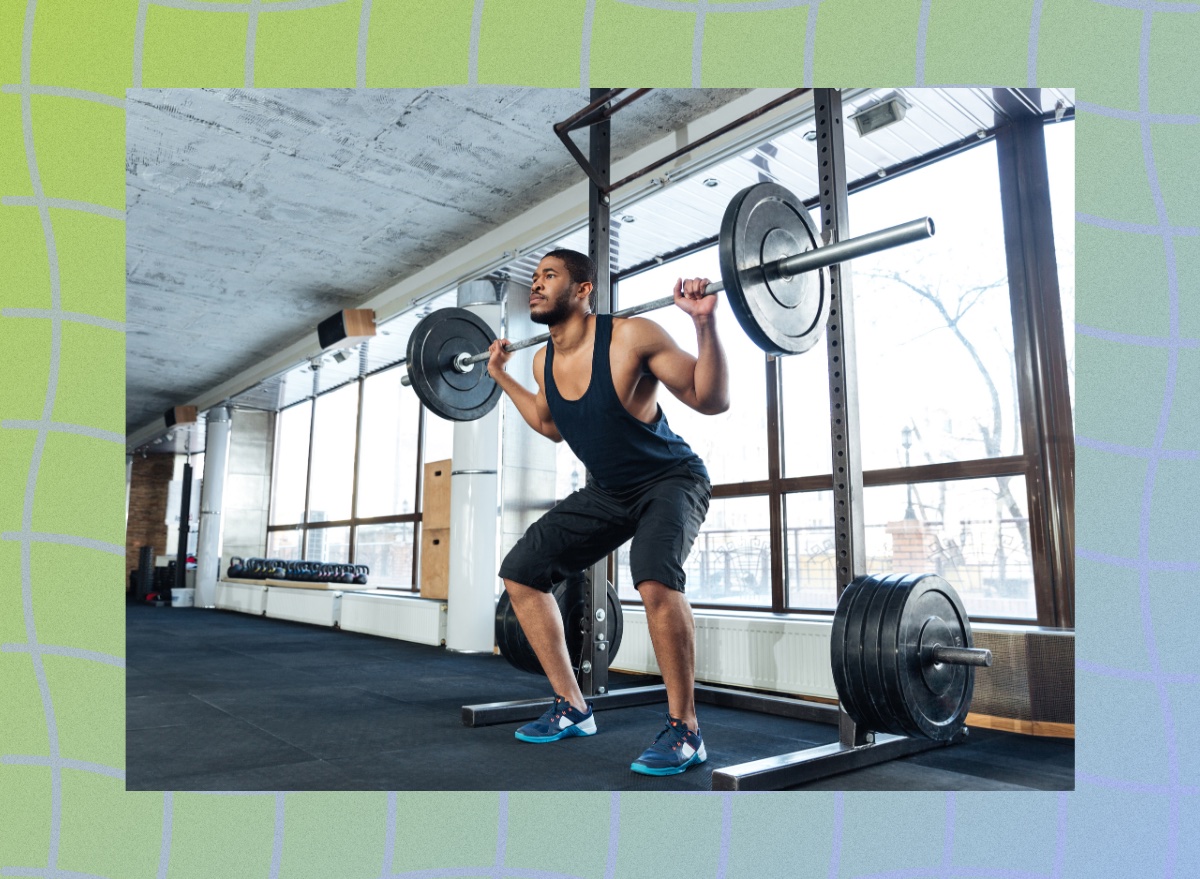
Reverse pyramid training (RPT) flips the script on traditional workouts. Whether you’ve been stuck on a plateau or just looking for a new challenge, RPT might be your next favorite way to push your limits and pack on some serious muscle. To help you get started, I’ve put together my go-to reverse pyramid workout to build muscle. But before we dive in, let’s talk a bit more about RPT and how it works.
Reverse pyramid training workouts are a game-changer for many fitness enthusiasts. Unlike the traditional pyramid structure, where you increase the weight and decrease the reps with each set, RPT does the opposite. When you’re fresh, you start with the heaviest weight, then progressively decrease the weight and increase the reps. This method lets you lift the maximum load when you have the most energy, leading to greater strength gains and muscle hypertrophy.
Benefits? Oh, there are plenty! RPT can break through strength plateaus, enhance muscle endurance, and optimize your time in the gym with highly efficient sessions.
If you’re intrigued, I’ll walk you through the ins and outs of reverse pyramid Training, providing you with a comprehensive guide on how to perform these workouts effectively. I’ll break down the principles of RPT and then dive into a detailed workout plan you can use today. Get ready to challenge yourself, lift heavier, and see those muscles grow!
How to Do a Reverse Pyramid Training Workout
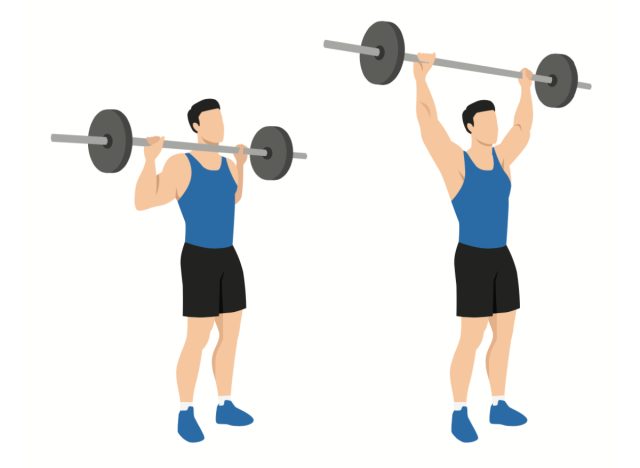
Reverse pyramid training is straightforward but incredibly effective. Here’s a step-by-step guide to get you started:
- Warm up properly: Before you begin your RPT workout, ensure your body is thoroughly warmed up. This means dynamic stretches and a few light sets of the exercise you’ll focus on. The goal is to prepare your muscles and joints for the heavy lifting.
- Choose your starting weight wisely: Your first set should be the heaviest, using a weight you can lift for about four to six reps. This is typically around 80% to 90% of your one-rep max. The key here is to push yourself but maintain proper form.
- First set: Perform four to six reps with your heaviest weight. This set should be intense and challenging as you work at your peak strength capacity.
- Rest and reduce the weight: After your first set, take a two to three-minute rest period. Reduce the weight by approximately 10% to 20% for your next set.
- Second set: Perform six to eight reps with the reduced weight. This set will still be challenging but should feel slightly easier than the first.
- Rest and reduce again: Rest for another two to three minutes and decrease the weight again by 10% to 20%.
- Third set: Aim for eight to 10 reps with a further reduced weight. This final set is where you’ll focus on muscle endurance.
- Cool down and stretch: After completing your RPT sets, cool down with light cardio and stretching to help you recover.
Full-Body Reverse Pyramid Training Workout
Now for the good stuff. Here’s a detailed, full-body workout plan tailored to help you build muscle with reverse pyramid training.
1. Back Squat
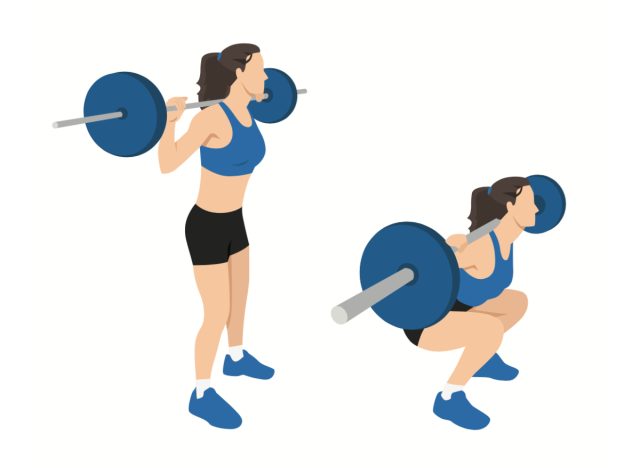
The back squat is a fundamental compound exercise that primarily targets the quadriceps, hamstrings, glutes, and lower back. This movement is crucial for building overall lower body strength and muscle mass. Additionally, back squats engage the core, improving stability and balance. Incorporating heavy back squats into your reverse pyramid training workout can significantly enhance your leg strength and promote hypertrophy in the lower-body muscles.
Start by positioning a barbell on a squat rack at about shoulder height. Step under the bar and place it across your upper back, gripping the bar with your hands slightly wider than shoulder-width apart. Stand up to lift the bar off the rack and take a step back. Position your feet shoulder-width apart, with your toes slightly pointed out. Engage your core, keep your chest up, and slowly lower your body by bending your knees and hips as if sitting back in a chair. Continue lowering until your thighs are at least parallel to the ground. Push through your heels to return to the starting position. Remember to keep your back straight and avoid letting your knees cave inward.
- Set 1: 4-6 reps (heaviest set)
- Rest: 2-3 minutes
- Set 2: 6-8 reps (reduce weight by 10% to 20%)
- Rest: 2-3 minutes
- Set 3: 8-10 reps (reduce weight by 10 % to 20%)
- Rest: 2-3 minutes
2. Dumbbell Bent-Over Row
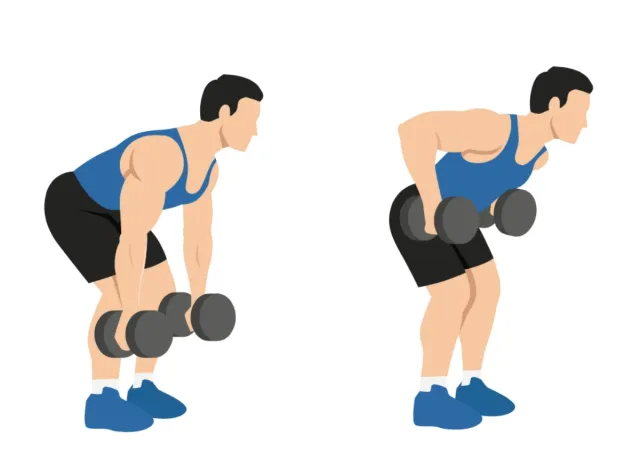
The dumbbell bent-over row develops a strong, muscular back. It targets the latissimus dorsi, rhomboids, and trapezius while engaging the biceps and rear deltoids. This movement helps improve posture, upper-body strength, and overall muscle definition in the back. You’ll maximize muscle growth and endurance by lifting heavy weights in the initial set and progressively reducing the load.
Hold a dumbbell in each hand with your palms facing your body. Stand with your feet shoulder-width apart and bend your knees slightly. Hinge at your hips to lean forward, keeping your back straight and core engaged. Let the dumbbells hang at arm’s length beneath your shoulders. Pull the dumbbells toward your torso, keeping your elbows close to your body and squeezing your shoulder blades together at the top of the movement. Lower the dumbbells back to the starting position with control. Avoid using momentum or rounding your back throughout the exercise.
- Set 1: 4-6 reps (heaviest set)
- Rest: 2-3 minutes
- Set 2: 6-8 reps (reduce weight by 10% to 20%)
- Rest: 2-3 minutes
- Set 3: 8-10 reps (reduce weight by 10% to 20%)
- Rest: 2-3 minutes
3. Barbell Romanian Deadlift (RDL)
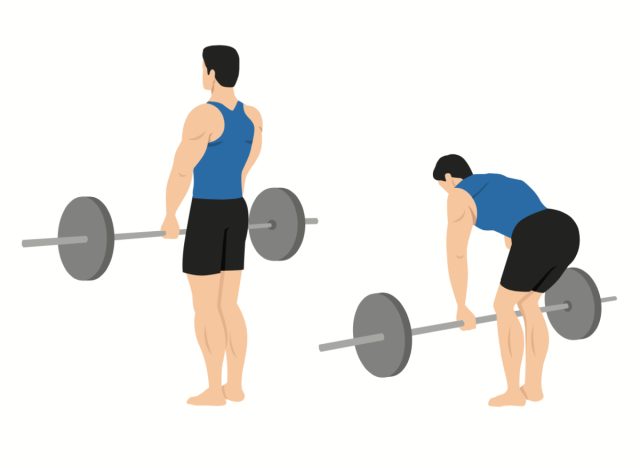
The barbell Romanian deadlift (RDL) is a fantastic exercise for targeting the posterior chain, including the hamstrings, glutes, and lower back. It also engages the core muscles for stability. RDLs are particularly effective for improving hamstring flexibility and strength, enhancing overall athletic performance, and reducing the risk of injury. Incorporating RDLs into your reverse pyramid training workout will help you develop a strong, balanced lower body.
Stand with your feet hip-width apart and a slight bend in your knees. Hold a barbell with an overhand grip in front of your thighs. Keep your back straight and core engaged as you hinge at your hips to lower the barbell toward the floor. Your knees should remain slightly bent throughout the movement. Lower the barbell until you feel a stretch in your hamstrings, keeping it close to your legs. Reverse the motion by driving your hips forward and standing up straight. Avoid rounding your back or letting the barbell drift away from your body.
- Set 1: 4-6 reps (heaviest set)
- Rest: 2-3 minutes
- Set 2: 6-8 reps (reduce weight by 10% to 20%)
- Rest: 2-3 minutes
- Set 3: 8-10 reps (reduce weight by 10% to 20%)
- Rest: 2-3 minutes
4. Dumbbell Incline Chest Press
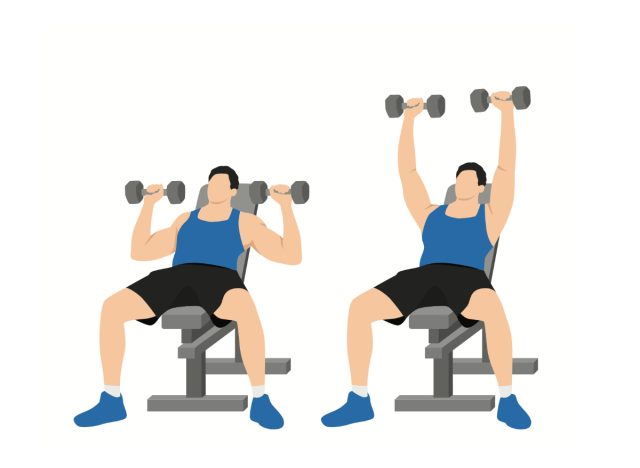
The dumbbell incline chest press is an excellent exercise for targeting the upper portion of the pectoral muscles and the anterior deltoids and triceps. By performing this movement on an incline bench, you emphasize the upper chest more, which can help create a more balanced and aesthetically pleasing physique. This exercise also promotes shoulder stability and overall upper-body strength.
Set an adjustable bench to a 30 to 45-degree incline. Sit on the bench with a dumbbell in each hand, resting them on your thighs. Lean back and position the dumbbells at shoulder height with your palms facing forward. Press the dumbbells upward until your arms are fully extended, then slowly lower them back to the starting position. Keep your elbows slightly bent at the bottom to maintain tension on the chest muscles. Avoid letting the dumbbells touch at the top, and focus on a controlled, steady movement throughout the exercise.
- Set 1: 4-6 reps (heaviest set)
- Rest: 2-3 minutes
- Set 2: 6-8 reps (reduce weight by 10% to 20%)
- Rest: 2-3 minutes
- Set 3: 8-10 reps (reduce weight by 10% to 20%)
- Rest: 2-3 minutes
5. Cable Face Pull
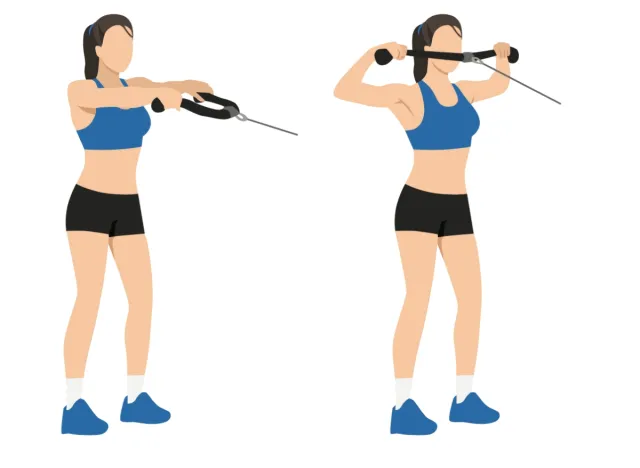
The cable face pull is potent for targeting the rear deltoids, upper trapezius, and rhomboids. It also engages the rotator cuff muscles, which are essential for shoulder stability and health. Face pulls help improve posture by strengthening the upper back and rear shoulder muscles, counteracting the effects of prolonged sitting and forward shoulder posture. Including face pulls in your RPT workout can enhance your overall shoulder and upper back development.
Attach a rope handle to a high pulley on a cable machine. Stand facing the machine, holding the rope with both hands and your palms facing each other. Step back to create tension in the cable. With your feet shoulder-width apart and a slight bend in your knees, pull the rope toward your face, flaring your elbows to the sides. Focus on squeezing your shoulder blades together at the peak of the movement. Slowly return the rope to the starting position. Keep your torso stable, and avoid using your lower body to generate momentum.
- Set 1: 4-6 reps (heaviest set)
- Rest: 2-3 minutes
- Set 2: 6-8 reps (reduce weight by 10% to 20%)
- Rest: 2-3 minutes
- Set 3: 8-10 reps (reduce weight by 10% to 20%)
- Rest: 2-3 minutes